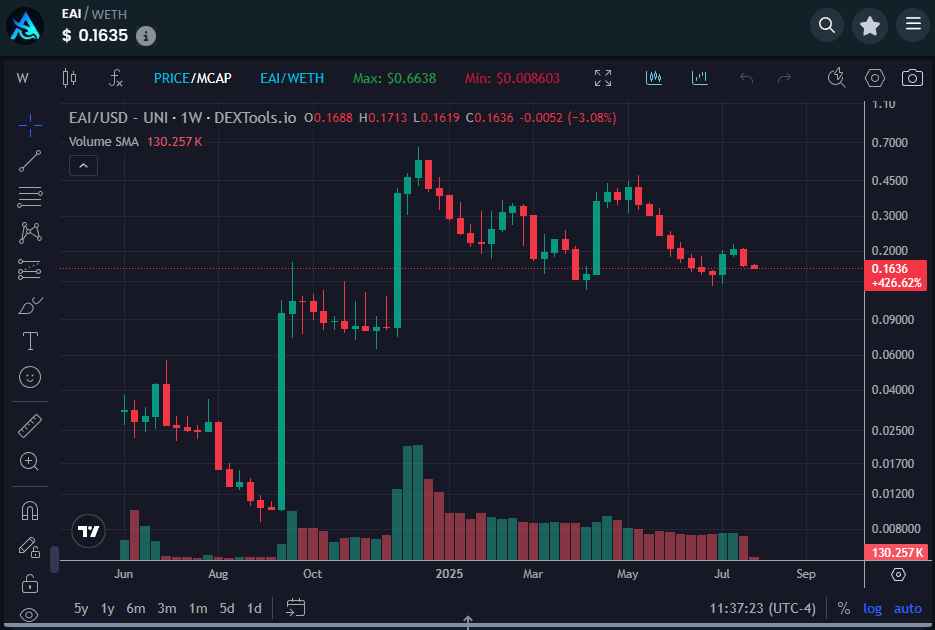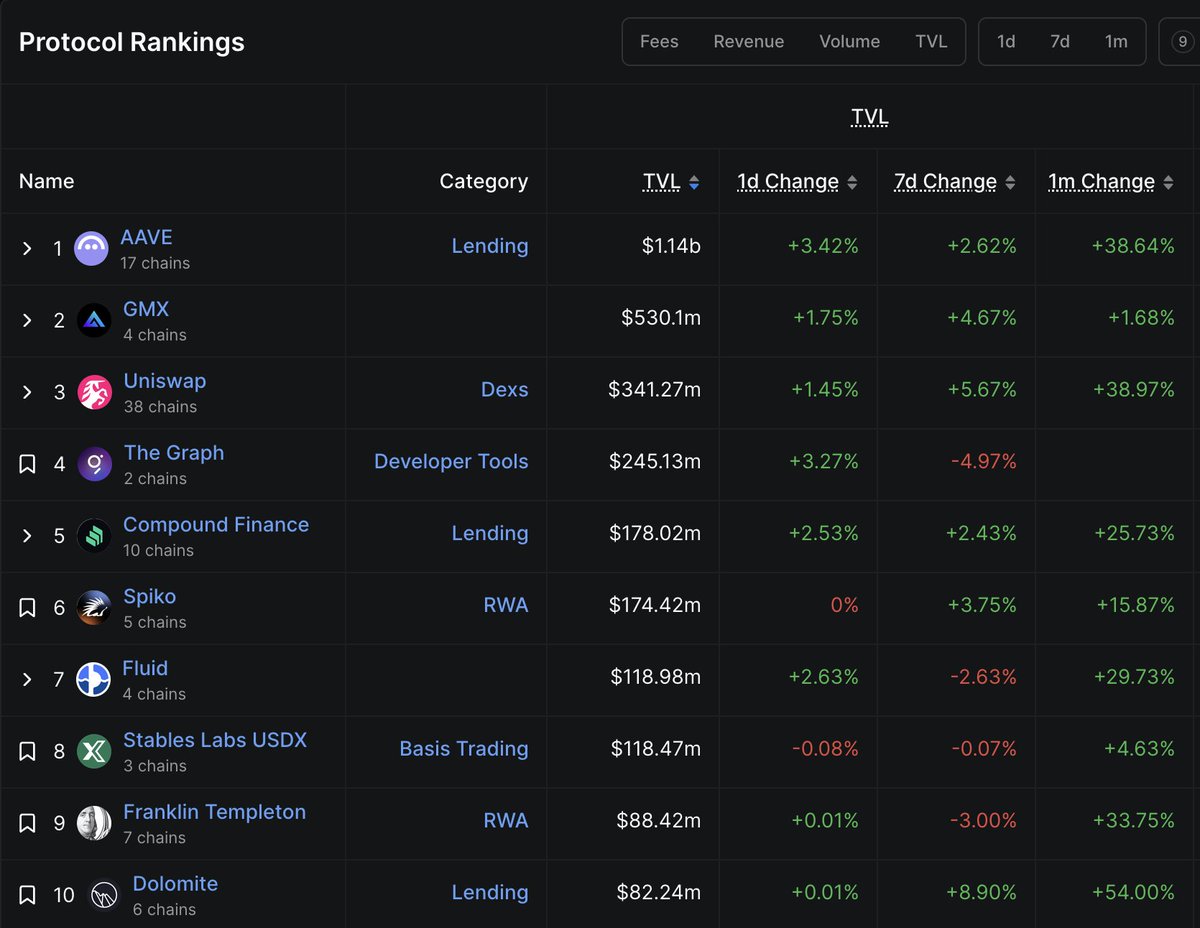Precio de Uniswap
en USD

Sobre Uniswap
Aviso
OKX no proporciona recomendaciones de inversión o de activos. Debes considerar cuidadosamente si el trading o el holding de activos digitales es adecuado para ti a la luz de tu situación financiera. Consulta a tu asesor legal/fiscal/profesional de inversiones para preguntas sobre tus circunstancias específicas. Para obtener más información, consulta nuestros Términos de uso y Advertencia de riesgo Al usar el sitio web de terceros ("Sitio web de terceros" o "TWP"), aceptas que el uso del TWP estará sujeto a los términos de TWP. Salvo que se indique expresamente por escrito, OKX y sus afiliados ("OKX") no están asociados de ninguna manera con el propietario u operador del TPW. Aceptas que OKX no es responsable de ninguna pérdida, daño ni cualquier otra consecuencia generada por tu uso del TPW. Ten en cuenta que usar un TWP puede generar una pérdida o reducción de tus activos. El producto puede no estar disponible en todas las jurisdicciones.
Rendimiento del precio de Uniswap
Uniswap en las redes sociales



Guía

Crea una cuenta de OKX gratis.
Añade fondos a tu cuenta.
Elige tus criptos.
Uniswap en Academia de OKX


Preguntas frecuentes sobre Uniswap
Descubre más sobre Uniswap
Uniswap es un intercambio descentralizado, comúnmente llamado DEX, desarrollado en la blockchain de Ethereum. Los traders utilizan Uniswap parahacer swap al instante de tokens ERC-20sin necesidad de un mercado líquido de compradores, vendedores o intermediarios. La red prioriza la resistencia a la censura, la seguridad y la autocustodia sin necesidad de intermediarios de terceros.
Al contrario de lo que ocurre con un exchange centralizado que procesa las órdenes de forma interna a través de un libro de órdenes, unexchange descentralizado opera un creador de mercado automatizado (AMM), que funciona como un pool de liquidez constante y sin permisos que los traders pueden interactuar directamente on-chain. UNI es el token nativo del protocolo Uniswap y se puede operar con él en varios mercados en OKX. UNI está obligado a votar sobre las propuestas que rigen el desarrollo de la plataforma Uniswap. También puedes utilizar UNI para crear pares de liquidez y ganar recompensas de criptos.
El ecosistema de Uniswap incluye las siguientes funciones:
- Uniswap Labs: la empresa que desarrolló el protocolo Uniswap.
- The Uniswap Protocol: Un exchange de cripto descentralizado en la blockchain de Ethereum.
- La interfaz de Uniswap: una interfaz web que permite a los usuarios interactuar con el protocolo.
- Uniswap Governance: Un sistema de gobernanza que utiliza el token UNI para gobernar el protocolo Uniswap.
Aunque inicialmente se desarrolló para la red Ethereum, Uniswap ya está operativo enPolygon,Arbitrumy de las blockchains Optimism. Esta flexibilidad de cadena cruzada es una de las cosas que los usuarios de finanzas descentralizadas adoran de Uniswap.
¿Cómo funciona Uniswap?
Uniswap es una plataforma de exchange descentralizado que facilita la creación de una enorme variedad de pools de liquidez que los traders pueden utilizar para hacer swap de tokens. Cualquier token compatible puede añadirse a un DEX y usarse para trading sin necesidad de una entidad o negocio centralizados para alojar el exchange.
Para habilitar esto,Uniswap utiliza contratos inteligentes, una utilidad fundamental en las finanzas descentralizadas, para permitir a los traders intercambiar tokens a través de un market maker automatizado. Un market maker automatizado, como Uniswap, es un medio de intercambio que permitirá a los traders intercambiar criptomonedas en pools de liquidez en la blockchain a través de la aplicación web de Uniswap. Al utilizar Uniswap, los usuarios no se verán limitados por factores externos como el tiempo de apertura del mercado y la necesidad de que otros traders cursen las órdenes correspondientes.
Para crear un pool de liquidez, un proveedor de liquidez debe suministrar dos tokens diferentes que pueden convertirse en un bote compartido con el que puedan operar los usuarios de Uniswap. El precio de los tokens en un pool de liquidez específico está regulado por una fórmula matemática que determina el valor de los tokens. Operar con un pool de liquidez cambia la proporción de tokens dentro del pool, provocando cambios en el precio de cada token.
Las comisiones de transacción fomentan que los proveedores de liquidez suministren tokens a un grupo de liquidez de Uniswap. Recibirán un porcentaje de cada operación que intercambiará tokens con el grupo.Aplicación descentralizada Uniswap (DApp)facilita la creación de una enorme variedad de pools de liquidez que los traders pueden utilizar para hacer swap de tokens. Cualquier token compatible puede añadirse a Uniswap y se puede operar con él sin que una entidad o negocio centralizados sea necesario para alojar el mercado.
Precio y tokenomía de UNI
UNI es unToken ERC-20 con un suministro en circulaciónde aproximadamente 734 000 000 y un suministro máximo génesis de 1000 000 000 tokens. Estos tokens se distribuirán de la siguiente manera a lo largo de cuatro años:
- Miembros de la comunidad Uniswap: 600,00 % (600 000 000 UNI).
- Empleados actuales y futuros: 21,266 % (221 660 000 UNI).
- Inversores: 18 044 % (1 180 440 000 UNI).
- asesores: 0,69 % (6 900 000 UNI).
El 15 % de la oferta total de UNI se puso inmediatamente a disposición de los "usuarios históricos y proveedores de liquidez". Esto se realizó para recompensar a los primeros miembros de la comunidad por su fe en la red y la liquidez. Además, el 43 % de los tokens UNI se retendrán en la tesorería de gobernanza de Uniswap. Estos 430 000 000 tokens se distribuirán a través de subvenciones para colaboradores, iniciativas de la comunidad, minería de liquidez y otros programas.
El suministro de UNI es inflacionario, siguiendo una tasa del 2 %, a partir de los 4 años posteriores a la acuñación del token. Este modelo inflacionario garantiza una participación continua y una contribución a la red Uniswap. La estructura de emisión de Uniswap indica que se alcanzará el suministro total máximo en septiembre de 2024.
Sobre el fundador
El desarrollo del protocolo Uniswap comenzó en 2017, cuando el fundador Hayden Adams fue expulsado de su puesto de ingeniero mecánico en Siemens. Adams se puso en contacto con su amigo cercano Karl Floersch para pedirle asesoramiento, y propuso que aprenda más sobre Ethereum y los contratos inteligentes. Para desarrollar sus habilidades de código y saber más sobre la tecnología blockchain, Adams comenzó a trabajar en un proyecto queVitalik Buterin, el fundador de Ethereum, ha descrito en Reddit, un popular foro en línea.
Adams fue completamente cautivado por las ideas que llevaron al proyecto Ethereum. Las misiones de descentralización y protocolos de permisos le llevaron a seguir desarrollando la plataforma Uniswap, a pesar de estar en el paro en ese momento. Se produjo un acontecimiento importante en abril de 2018, cuando Adams fue introducido en Vitalik Buterin en la conferencia de Deconomy de Qatar. Buterin leyó sobre el código fuente de Adam y le aconsejó que solicitara una ayuda de la Fundación Ethereum y que continuara desarrollando Uniswap en Vyper, un lenguaje de programación diferente.
Tras varios meses de desarrollo continuo, el exchange descentralizado de Uniswap se implementó por fin en la mainnet de Ethereum en noviembre de 2018. Sin embargo, el equipo no se detuvo allí y, hasta el día de hoy, sigue mejorando la plataforma con actualizaciones frecuentes. Un ejemplo de esto son los niveles opcionales de comisiones de transacción en Uniswap V3. Esto permite a los proveedores de liquidez decidir cuánto tienen que pagar los traders en las comisiones de transacción al realizar operaciones. Hoy en día, Uniswap mantiene el mayor valor total bloqueado (TVL) de cualquier exchange descentralizado en Ethereum:blockchain de contratos inteligentes de capa 1 más grandeen el sector de las criptomonedas.
Como pionero en este campo, Uniswap consiguió atraer un interés significativo de varios inversores institucionales conocidos. Los inversores más importantes, como Delphi Digital, Pantera Capital, a16z Crypto y Blockchain Capital, apoyaban y financiaban Uniswap. Estos fondos, que contaban con mucha experiencia, ayudaron al desarrollo de Uniswap y contribuyen significativamente a su éxito actual.
Uniswap destaca
NFT en Uniswap
Uno de los desarrollos más emocionantes y debates que ha llegado a Uniswap es la integraciónun agregador de tokens no fungibles (NFT)en la plataforma. En junio de 2022, Uniswaps Labs anunció que habían adquirido Genie y lo implementarían en el sitio de Uniswap.
Genie es un agregador de NFT. Esto significa que los posibles compradores de NFT pueden utilizar Genie para recolectar y comprar NFT publicados en cualquier mercado en un solo lugar. Esto simplifica el proceso de la colección de NFT y elimina la necesidad de comprobar la necesidad de varios mercados para conseguir las mejores ofertas. Se trata de un paso muy importante en el desarrollo del proyecto, que ha hecho que los usuarios de DeFi y los coleccionistas de NFT estén muy preocupados por Uniswap.
El Widget de swap
En abril de 2022, el desarrollo de Uniswap presentó y implementó el Swap Widget, una sencilla función de swap que los desarrolladores podrían integrar fácilmente en sus aplicaciones. El Swap Widget permite a los usuarios operar con tokens desde un sitio de terceros en lugar de navegar a la aplicación web de Uniswap. El Swap Widget puede añadirse a una dApp compatible con una sola línea de código y ya lo están usando algunos sitios populares como OpenSea.
Declaración de GEI




































